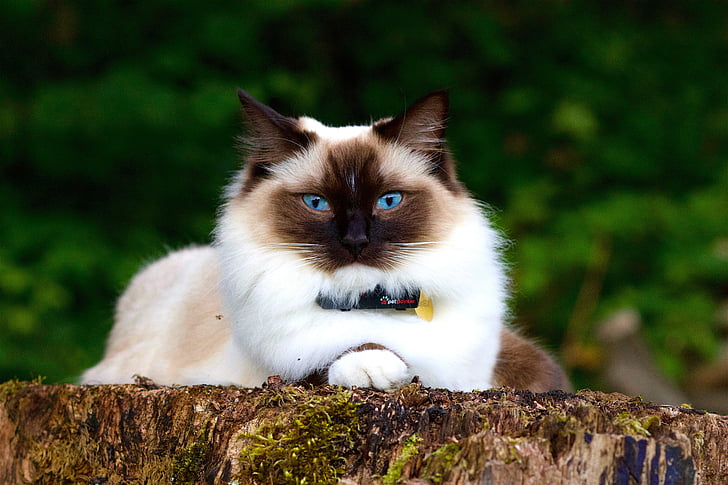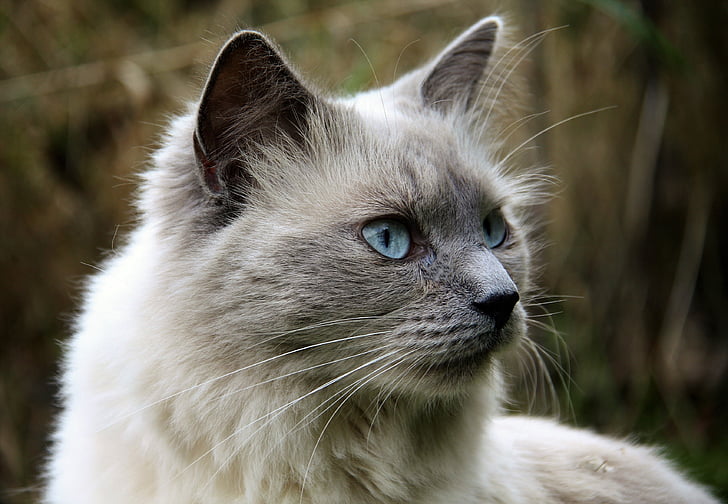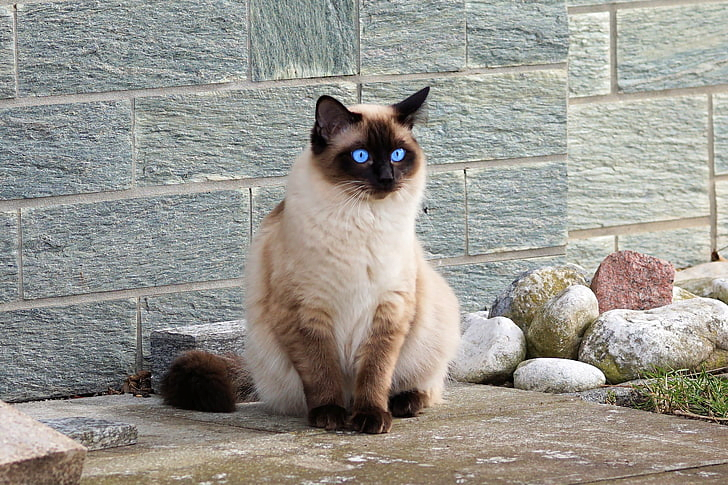Himalayan cats, often celebrated for their striking appearance and gentle temperament, are a hybrid breed that combines the best traits of Persian and Siamese cats. These fluffy companions boast long, luxurious coats and vivid blue eyes, making them a visually captivating addition to any home. Despite their regal looks, Himalayans are known for their playful yet laid-back nature, fitting seamlessly into various household dynamics. They crave affection and form strong bonds with their families, thriving in environments where they can receive plenty of attention and care. Understanding the unique needs of a Himalayan cat, from grooming requirements to social interactions, is essential for potential owners looking to welcome this breed into their lives.
Key Takeaways
- Himalayan cats are a beautiful and affectionate breed that combines the luxurious coat of a Persian with the striking blue eyes and color points of a Siamese.
- Regular grooming is essential for Himalayans to prevent matting and maintain their coat’s health, highlighting the importance of brushing their fur daily.
- When considering a Himalayan cat’s health, be aware of potential breed-specific issues such as respiratory and kidney problems, emphasizing the need for regular veterinary check-ups.
- Creating a comfortable living environment for a Himalayan cat includes providing plenty of playtime, a calm atmosphere, and attention to their social needs.
- If you’re looking to adopt a Himalayan, seeking advice from reputable breeders or adoption centers is crucial to ensure the health and well-being of your future pet.
- The miscellaneous aspects of owning a Himalayan, like their characteristic meow and laid-back personality, make them a unique addition to any home, suitable for families and singles alike.
Breed Overview
History
The Himalayan cat, a striking blend of Persian and Siamese breeds, emerged in the 1950s. This crossbreeding effort aimed to combine the Persian’s luxurious coat with the Siamese’s vivid blue eyes and unique color points. The breed faced initial resistance but eventually gained official recognition from major cat registries. Its journey to popularity was marked by both controversy and admiration within the cat fancier community. Over time, the Himalayan cat carved out its niche, becoming a beloved breed among cat enthusiasts worldwide.
Recognition did not come overnight. It took years of dedicated breeding and advocacy for the Himalayan to be accepted as a distinct breed. Today, it stands as a testament to the perseverance of its early breeders.
Physical Characteristics
Himalayan cats boast a distinctive long, fluffy coat that demands regular grooming. Their deep blue eyes are a mesmerizing feature inherited from their Siamese ancestors. These cats are medium to large in size, embodying grace and strength in their build. The color points on their face, ears, paws, and tail resemble those found in Siamese cats and come in various shades including chocolate, seal, lilac, and blue. These color points set them apart from other breeds, making them highly sought after for their beauty.
Their physical attributes require attention from owners to maintain their health and appearance. Regular brushing is essential to prevent matting and keep their coat in pristine condition.
Personality and Temperament
Himalayan cats are known for their affectionate and gentle nature. They thrive in calm environments where they can receive plenty of love and attention from their human companions. Despite their serene demeanor, they possess a playful side that makes them delightful companions. Their intelligence allows them to engage in interactive play and even learn tricks or commands.
These cats also inherit vocal tendencies from their Siamese lineage; however, they tend to be less loud. They communicate effectively with their families without being overwhelming. This balance between expressiveness and tranquility makes them ideal pets for those seeking an engaging yet undemanding feline friend.

Health And Care
Common Health Issues
Himalayan cats inherit certain health issues from their Persian ancestors. They often face respiratory and kidney problems. Owners should be vigilant about these conditions.
Eye problems, such as progressive retinal atrophy, also pose a risk. This makes regular vet visits crucial for early detection of breed-specific issues.
Dietary Needs
Obesity can easily affect less active breeds like the Himalayan cat. A balanced diet is key to avoiding this problem. High-quality cat food meets their unique dietary needs effectively.
Clean, fresh water supports their kidney health. It must always be available to them.
Exercise Requirements
Interactive play keeps Himalayans both physically fit and mentally sharp. Cat trees and perches encourage climbing, which is great for muscle tone.
Daily exercise is essential to fend off obesity in these cats.
Grooming
Their long fur requires daily brushing to avoid mats. Regular ear cleaning and nail trimming are also important parts of their care routine.
Occasional baths maintain their coat’s condition, ensuring it stays healthy and clean.
Living with a Himalayan
Training and Socialization
Himalayan cats are known for their intelligence, which makes them relatively easy to train. They respond well to patience and positive reinforcement. Treats and praise can go a long way in teaching them new tricks or behaviors.
Early socialization is crucial for Himalayans. It helps them become well-adjusted adults. Introducing them to different people and other pets at a young age is beneficial. This breeds confidence and sociability.
For litter box training, start early. Use a clean, accessible box and unscented litter. Himalayans prefer cleanliness, so keeping the litter box tidy encourages its use.
Environment
A quiet, stable home matches their calm temperament perfectly. Himalayans thrive in peaceful surroundings. Sudden changes or loud environments can stress them out.
They need space to explore and play. Ensure your home offers plenty of room for these activities. Cat trees and scratching posts are great additions.
Making your home safe is vital. Cat-proofing prevents accidents or injuries. Secure windows and remove toxic plants to create a secure environment for your Himalayan cat.
Activities They Enjoy
Himalayans enjoy various activities that keep both their mind and body active. Puzzle toys offer mental stimulation, while feather wands encourage physical exercise.
They love high perches and window sills. These spots allow them to observe their surroundings safely. It satisfies their curiosity without putting them in harm’s way.
Gentle interaction is another favorite activity of Himalayans. They cherish cuddle time with their owners, strengthening the bond between pet and owner.

Breeder Advice and Adoption
Choosing a Breeder
Finding a reputable breeder is crucial when looking to bring a Himalayan cat into your home. These breeders prioritize the health and well-being of their cats, conducting thorough health screenings to ensure they are free from genetic diseases common to the breed. It’s essential to ask for health clearances as proof of these screenings.
Visiting the breeding facility gives insight into the environment where the kittens grow up. Look for clean, spacious areas that allow the cats to play and interact. Breeders who socialize their kittens early on help ensure they are well-adjusted and friendly pets.
Transparency about any potential health issues within the breed is also vital. A trustworthy breeder will discuss these openly, helping you prepare for any future healthcare needs your pet might have.
Adoption
Adoption offers a meaningful way to welcome a Himalayan cat into your life. Many shelters and rescue organizations specialize in specific breeds, including Himalayans. They work hard to care for these cats until they find their forever homes.
When considering adoption, pay close attention to the cat’s temperament and health status. Shelters often provide a history of their animals, which can include information on their behavior and any medical conditions they may have.
Adopting an adult Himalayan has its benefits. Adult cats usually have established personalities and behaviors, making it easier to find one that fits your lifestyle. Plus, adopting an adult cat can be incredibly rewarding as you give them a second chance at a loving home.
Misc.
Popular Names
Himalayan cats often carry names that reflect their royal and exotic origins. Luna, Simba, and Bella rank among the most common choices. Owners might pick a name that mirrors their cat’s personality or unique physical features. There’s also a trend of naming Himalayans after famous movie or literary characters, thanks to their dramatic looks.
Choosing the right name is more than just a fun task. It can highlight the cat’s majestic presence in any room.
Fun Facts
The Himalayan cat has a rich history, once considered its own breed but now often seen as a Persian variant. These cats have made appearances in pop culture, notably in “Meet the Parents.” Despite their calm demeanor, Himalayans may surprise you with sudden bursts of energy and playfulness.
This blend of traits makes them fascinating pets and companions.
Common Myths
Contrary to popular belief, Himalayans are not high-maintenance. Their grooming needs are quite manageable with regular care. They’re also unfairly labeled as standoffish with kids or other pets. In reality, they adapt well and show gentleness around family members.
Moreover, while they do enjoy lounging, Himalayans have moments where they’re as playful as any kitten, needing exercise to stay happy and healthy.
Most Similar Breed
Himalayans share many qualities with Persians, including their luxurious coats and care requirements. However, Himalayans stand out with their distinctive color points and tend to be slightly more active. For those drawn to similar breeds, the Ragdoll offers comparable temperament and care needs.
Understanding these similarities helps potential owners find the perfect fit for their homes.

Top Cat Grooming Tools (Click Here)
Summary
The Himalayan cat, with its distinctive appearance and affectionate nature, has been thoroughly explored from breed specifics to care requirements. This breed demands attention to health, grooming, and living conditions to ensure a happy life. Their unique needs, coupled with insights on responsible adoption and breeder selection, highlight the importance of informed caregiving. The exploration of miscellaneous aspects further enriches understanding, ensuring prospective owners are well-equipped for welcoming a Himalayan into their home.
Adopting a Himalayan cat is a rewarding experience that requires commitment. It’s essential for potential owners to research and consider all aspects discussed before making a decision. Engaging with reputable breeders or adoption centers ensures the well-being of these majestic creatures. Let this guide serve as a stepping stone towards a fulfilling journey with a Himalayan cat, fostering a loving and healthy environment for them to thrive in.
Frequently Asked Questions
What is the lifespan of a Himalayan cat?
Himalayan cats typically live between 9 to 15 years. Proper care, diet, and regular veterinary check-ups can contribute to a longer lifespan.
How should I care for my Himalayan cat’s fur?
Regular grooming is essential for Himalayan cats due to their long, dense fur. Brushing them daily helps prevent matting and reduces shedding.
Are Himalayan cats good with children?
Yes, Himalayan cats are generally good with children. They are known for their gentle and calm demeanor, making them suitable for families.
What health issues are common in Himalayan cats?
Himalayan cats are prone to certain health issues such as respiratory problems due to their flat faces, kidney disease, and eye conditions like progressive retinal atrophy.
Can Himalayan cats adapt well to indoor living?
Absolutely. Himalayan cats thrive in indoor environments. Their calm nature makes them well-suited to living indoors where they can be safe and comfortable.
What advice do breeders give about adopting a Himalayan cat?
Breeders often advise ensuring that you’re ready for the commitment of grooming and caring for a long-haired breed. They also recommend adopting from reputable sources that test for genetic health issues.
Is it easy to train a Himalayan cat?
Himalayan cats can be trained with patience and consistency. They respond well to positive reinforcement techniques such as treats and praise.






0 Comments